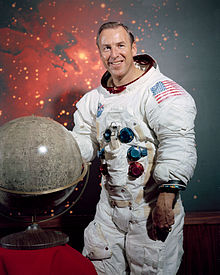James Lovell
| James "Jim" Lovell | |
|---|---|
 | |
| NASA Astronaut | |
| Statsborger | USA |
| Nationalitet | Amerikaner |
| Status | Pensioneret, var Astronaut |
| Født | 25. marts 1928 Cleveland, Ohio |
Andet arbejde | Testpilot |
| Uddannelses- sted | United States Naval Test Pilot School University of Southern California Harvard Business School United States Naval Academy MacDowell Montessori School University of Wisconsin–Madison |
| Rang | Kommandør United States Navy (OF-5) |
Tid i rummet | 29 dage, 18 timer |
| Udvælgelse | Astronautgruppe 2 1962 |
| Mission(er) | Gemini 7, Gemini 12, Apollo 8, Apollo 13 |
| Missionsemblemer | |
James Arthur Lovell (født 25. marts 1928) er en tidligere amerikansk astronaut. Han er mest kendt i forbindelse med Apollo 13 missionen, der skulle have været til månen, men da en tank eksploderede, blev det i stedet en redningsmission. Han er forfatter til en bog om Apollo 13 missionen. Bogen er blevet filmatiseret med Tom Hanks i hovedrollen som James Lovell.
- Lovell var substitut for Neil Armstrong på Apollo 11 missionen.
- Indtil Skylab-programmet (1973) havde Lovell rekorden på 715 timer i rummet.
- Efter astronautkarrieren havde han flere direktørstillinger og bestyrelsesposter.
Ungdom og uddannelse
Lovell er født i Cleveland, Ohio. Hans mor var tjekkisk. Lovells familie flyttede til Milwaukee, Wisconsin, hvor han bestod eksamen på Juneau High School og blev en Eagle Scout. [1] Hans far døde i en bilulykke, da Lovell var ung, og i omkring 2 år boede Lovell hos en slægtning i Terre Haute, Indiana.
Som dreng interesserede han sig for raketter og for at bygge modelfly.
I 1952 giftede han sig med Marylin Gerlach. De har fire børn sammen: Barbara (født 1953), James (1955), Susan (1958) og Jeffrey (1966).
Se også
Referencer
- ^ "ohiohistory.org". Arkiveret fra originalen 31. marts 2012. Hentet 29. oktober 2012.
Eksterne henvisninger
- Biografi James Arthur Lovell NASA (engelsk)
|
Medier brugt på denne side
Portrait of astronaut James A. Lovell, Jr. in his space suit beside a model of the Moon.
View of Mission Control Center during the Apollo 13 oxygen cell failure
Several persons important to the Apollo 13 mission, at consoles in the Mission Operations Control Room of the Mission Control Center (MCC). Seated at consoles, from left to right, are Astronaut Donald K. Slayton, Director of Flight Crew Operations; Astronaut Jack R. Lousma, Shift 3 spacecraft communicator; and Astronaut John W. Young, commander of the Apollo 13 back-up crew. Standing, left to right, are Astronaut Tom K. Mattingly, who was replaced as Apollo 13 command module pilot after it was learned he may come down with measles, and Astronaut Vance D. Brand, Shift 2 spacecraft communicator. Several hours earlier crew members of the Apollo 13 mission reported to MCC that trouble had developed with an oxygen cell in their spacecraft.
Logo Apollo 13
This is the insignia of the Apollo 13 lunar landing mission. The Apollo 13 prime crew were the astronauts James A. Lovell Jr., commander; Thomas K. Mattingly II, command module pilot; and Fred W. Haise Jr., lunar module pilot. Represented in the Apollo 13 emblem is Apollo, the sun god of Greek mythology, symbolizing how the Apollo flights have extended the light of knowledge to all mankind. The Latin phrase Ex Luna, Scientia means "From the Moon, Knowledge." Apollo 13 was intended to be the National Aeronautics and Space Administration's (NASA) third lunar landing mission.
Rear Admiral Donald C. Davis welcomes the Apollo 13 crewmembers aboard the recovery ship USS Iwo Jima. The crewmembers are (from the left) astronauts Fred W. Haise Jr. (waving), John L. Swigert Jr. and James A. Lovell Jr.
Design for the emblem of the Gemini VII spaceflight. At left of hand-held torch is a Gemini spacecraft. Roman numeral indicates the seventh flight in the Gemini series. Prime crew men for the mission are astronauts Frank Borman, command pilot, and James A. Lovell Jr., pilot. The NASA insignia design for Gemini flights is reserved for use by the astronauts and for other official use as the NASA Administrator may authorize. Public availability has been approved only in the form of illustrations by the various news media. When and if there is any change in this policy, which we do not anticipate, it will be publicly announced.
This is the Apollo 8 mission patch. Designed by Jim Lovell
This is the official emblem of the Apollo 8 lunar orbit mission. The crew will consist of astronauts Frank Borman, commander; James A. Lovell Jr., command module pilot; and William A. Anders, lunar module pilot.
Crewmen aboard the USS Iwo Jima, prime recovery ship for the Apollo 13 mission, guide the Command Module (CM) atop a dolly onboard the ship. The CM is connected by strong cable to a hoist on the vessel. The Apollo 13 crewmembers, astronauts James A. Lovell Jr., commander; John L. Swigert Jr., command module pilot; and Fred W. Haise Jr., lunar module pilot, were already aboard the USS Iwo Jima when this photograph was made. The CM, with the three tired crewmen aboard, splashed down at 12:07:44 p.m. (CST), April 17, 1970, only about four miles from the recovery vessel in the South Pacific Ocean.











